#cornish folk tales
Text

Very much in love with the art from the painting of the Mermaid of Zennor
#mermaid of zennor#cornish folk tales#medieval#john reinhard weguelin#kraftykelpie's art#illustration#mermaids#fantasy#mythology#my art#for i am more than what the legends say of me (art tag)
6 notes
·
View notes
Text
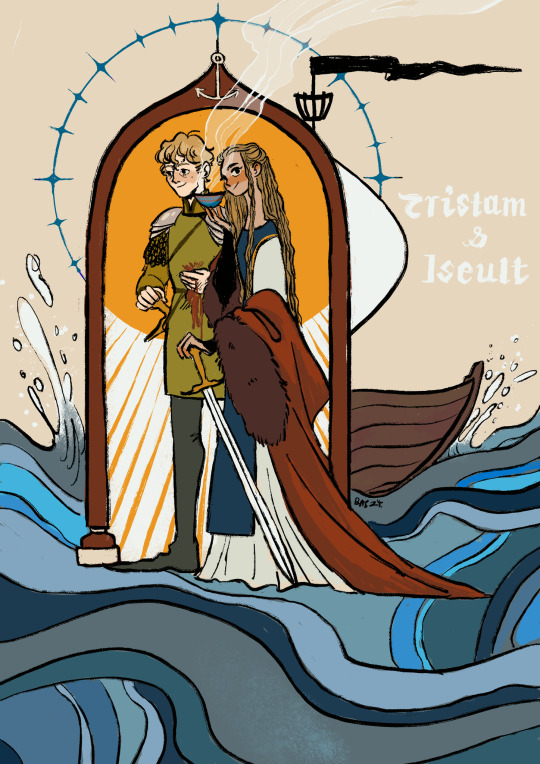
folkbruary #6
tristam & iseult
#ach this tale gets me every time#folk art#tristam and iseult#tristan and isolde#brythonic folklore#Cornish folklore#breton folklore#folklore art#fantasy art#cover art#digital illustration#folkbruary#folkbruary 24#basil draws
43 notes
·
View notes
Text


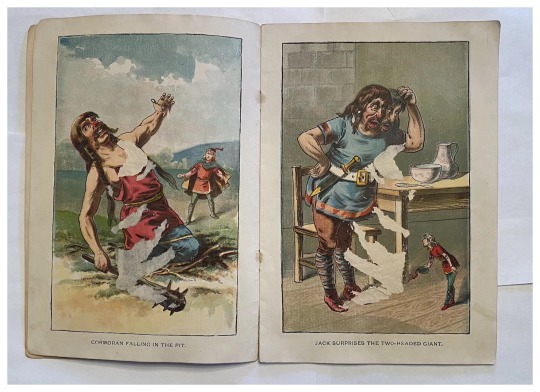



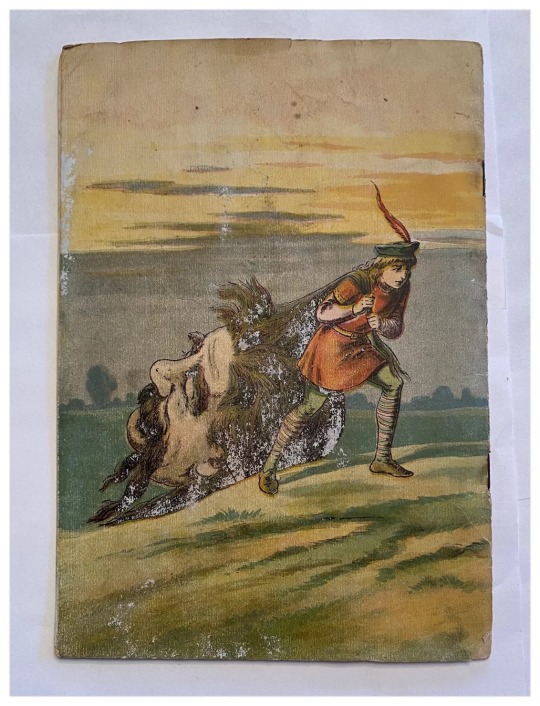
#jack the giant killer#english#fairy tales#fairy tale#folklore#folk tales#cornish#british#england#britain#cornwall#giants#monsters#monster#giant#slayer#ogres#mythology#jack tales#tales#jack and the beanstalk#jack the giant slayer#hero#arthurian#king arthur#jack#magic#english fairy tales
39 notes
·
View notes
Text
one-page wonders
when I first began to write games, I started with the single page. short and sharp, pushing the limits of how much historical detail or genre trappings could be packed within that form factor.
these games are dense, and rough around the edges, and clumsily laid-out, but they're charming and they're strongly voiced and they know exactly what they want to be.
i'm proud of them, still. so—50% off, and a bundle of all 5 for $15.
it's good to remember I once made short games quickly, as I coax a half-dozen projects destined for print someday through the development process, and see my first big publication crowdfund looming on the horizon.
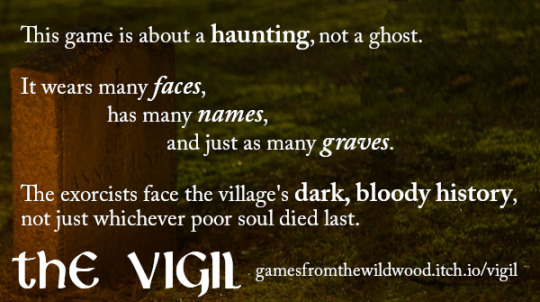
The Vigil tells the story of one night's terrible work for a crew of exorcists in Dark Ages England. It is a historical horror RPG about how communities are haunted by their pasts, and their sins.
I was tired of knowable ghosts when I wrote this game, and wondering what it means to be a community under siege by your whole bloody history—not just one restless soul. The haunting tables are the highlight, of course.

Shipwreckers tells the story of one night in the lives of a crew of daring folks working the Cornish coast as shipwreckers in the late 1700s. It is a historical RPG oneshot about bravery, poverty, superstition, and a little-known moment in history.
My second ever game, and my first one-pager. The clearest and tightest call to action (and stopping point) of all of them.
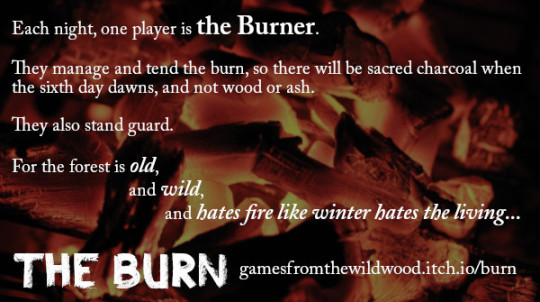
The Burn tells the story of a band of charcoal burners tending their fragile fire, and the visitors they face in the unfriendly shadow of the forest. It is a GMless historical RPG about ritual, sacrifice, and vigilance that is played with cards, dice, candles, and matches.
I wrote this game waiting for a plane in January 2020, as Australia burned. I needed to remember that fire could also be creative and protective, and it helped. It’s possibly the quickest game I’ve ever written.
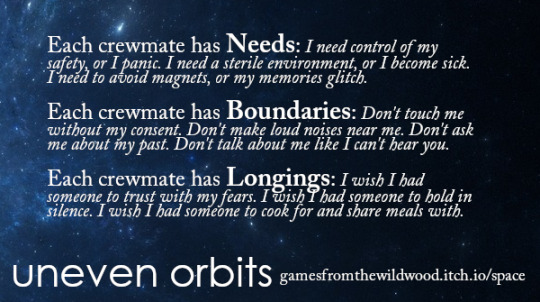
Uneven Orbits tells the story of a ship, its crew, and the uncertain journey which brings them close. It is a GMless sci-fi RPG about how we negotiate relationships, seek out intimacy, and learn to live with one another.
If you’re a fan of A Long Way to A Small Angry Planet, but also the crew-becomes-family tropes of Firefly and Star Wars, this game may speak to you.

Wayfaring Strangers tell the story of a group of travelers brought together by wild weather, and the tales they tell until dawn. It is a GMless Tarot-based RPG about companionship and storytelling.
I loved Where the Water Tastes Like Wine, and the World’s End arc of Sandman. I also just love tall tales, ghost stories, and the like. And so this game: a thin pretext to justify swapping yarns with your friends and dreaming up stories on the spot.
69 notes
·
View notes
Text
Lady Stoneheart + Sir Gawain and the Green Knight: Parallels and Symbolism


The steel was polished to such a high sheen that she could see her reflection in the breastplate, gazing back at her as if from the bottom of a deep green pond. The face of a drowned woman, Catelyn thought. Can you drown in grief? — Catelyn, ACOK
Catelyn's face reflected in renly's green armour reminded me of the story of Sir Gawain and the Green Knight. I decided to dig into it and surprisingly found many things evocative of Lady Stoneheart.
1. A Judge
The Green Knight appears in Arthurian tales as a judge or tester of knights, challenging them to honour their promises. Lady Stoneheart plays a similar role in ASOIAF by demanding that jaime and brienne honour their promise to return her daughters or face death.
2. Colours: Green + Grey
It has been argued that green is wrongly attributed to the green knight owing to a mistranslation of the Cornish word glas, which means grey. In another variation of the story, the knight is often called "the man of the grey mantle".
Lady Stoneheart is heavily associated with grey.
Grey was the color of the silent sisters, the handmaidens of the Stranger. Brienne felt a shiver climb her spine. Stoneheart. — Brienne, AFFC
3. Identities and Aliases
At the end of the story, the green knight reveals himself to be Bertilak de hautdesert, Lord of a castle. Before getting resurrected as a fire wight, Lady Stoneheart was Catelyn tully stark.
On my honour as a Tully, on my honour as a Stark. — Catelyn, ASOS
4. A Game (of thrones)
The word gomen (game) is found 18 times in Gawain. Its similarity to the word gome (man), which appears 21 times, has led some scholars to see men and games as centrally linked.
The story itself began with a "Christmas game", known in folk stories as a "beheading game".
What... what game?
The only game. The game of thrones.
Catelyn ends up as Lady Stoneheart because her son wins every battle but loses the war, i.e., loses the game of thrones. Catelyn too was one of the players of the game, of course.
5. Winter, seasonality, and the rise and fall of things


The Green Knight tells Gawain to meet him at the Green Chapel in "a year and a day"—in other words, the next New Year's Day. Scholars interpret the yearly cycles, each beginning and ending in winter, as the poet's attempt to convey the inevitable fall of all things good and noble in the world
Winter is of course an extremely important motif in ASOIAF:
They are the knights of Summer, and winter is coming. — Catelyn, ACOK
It's also interesting to note that feasts are important events in both stories: the green knight first appears at a Christmas feast and Catelyn is killed at a wedding feast.
6. Trophies and Temptation: Girdles and Flayed skins

Roose bolton offers a piece of theon's flayed skin to Catelyn, and she is tempted to accept it.
"May I offer you this…small token of revenge?" Part of Catelyn wanted to clutch the grisly trophy to her heart, but she made herself resist. — Catelyn, ASOS
As Lady Stoneheart, she fully gives in to her temptation and ruthlessly pursues revenge.
"...She wants to feed the crows, like they did at the Red Wedding. Freys and Boltons, aye. We'll give her those, as many as she likes." —Brienne, AFFC
In Gawain's story, he is gifted a girdle by his hostess, the Lady Bertilak. He had earlier promised his host that he'd return whatever he got at the end of the day, but Lady Bertilak insists that it's a magical girdle that will prevent Gawain from being killed at the hands of the green knight. He gives in to temptation and keeps the girdle.
7. Chivalry and Contradictions: So many vows
The knight's code of honour requires Gawain to do whatever a damsel asks. Gawain must accept the girdle from the Lady, but he must also keep the promise he has made to his host that he will give whatever he gains that day. Gawain chooses to keep the girdle out of fear of death, thus breaking his promise to the host but honouring the lady.
Gawain's dilemma about whether to keep the girdle as ordered by his hostess or return it to his host and honour his promise to him reflects jaime's dilemma and the contradictory vows of knighthood.
So many vows...they make you swear and swear. Defend the king. Obey the king. Keep his secrets. Do his bidding. Your life for his. But obey your father. Love your sister. Protect the innocent. Defend the weak. Respect the gods. Obey the laws. It's too much. No matter what you do, you're forsaking one vow or the other. — Jaime, ACOK
It's also interesting to note that the five pointed star or the pentangle is heavily associated with Gawain, reminiscent of the seven pointed star of the faith associated with Westerosi knights (and by extension with jaime) as they are anointed by the faith.
8. Wounds to the neck
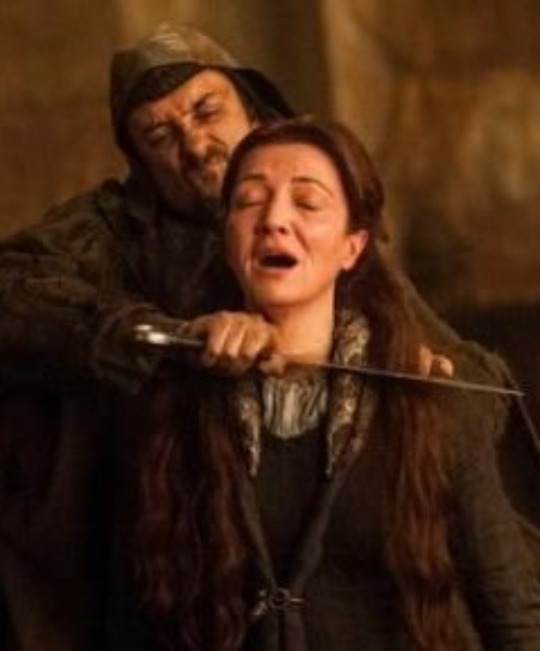

Catelyn's throat is slit by the freys before they dumped her in the river, and as a result, she is unable to speak properly.
At the story's climax, Gawain is wounded in the neck by the Green Knight's axe.
The symbolism surrounding wounds:
During the medieval period, the body and the soul were believed to be so intimately connected that wounds were considered an outward sign of inward sin. The neck, specifically, was believed to correlate with the part of the soul related to will.
Hope you enjoyed this post!
#catelyn stark#asoiaf#lady stoneheart#the green knight#literature#sir gawain#jaime lannister#asoiaf mythology parallels#catelynisms#arthurian legend
35 notes
·
View notes
Text
Rules: in a new post, show the last line you wrote (or drew) and tag as many people as there are words (or as many as you feel like).
Thanks for the tag @the-real-housewives-of-waterdeep <3
I'm currently writing a novel exploring british folk-lore and the portrayal of women. It features a 'Selkie' and a 'Hag' in a small seaside town which becomes popular with tourists after a tragedy occurs and the tale of the jealous cornish Selkie starts to spread.
On the steepest cliff along the coastline, the hag’s salt-wind battered house sits sentinel-like and vigilant above the lights of the town.
I’m tagging @weaveandwood, @mumms-the-word, @alpydk, @orangekittyenergy, @lewdisescariot, @fantasyfictionfables @dr-demi-bee @magspeaches @gale-force-storm @auroraesmeraldarose
And EVERYONE ELSE because i'm a nosy friendship goblin and I want to know what you're all working on. You creative little fucks.
8 notes
·
View notes
Note
Hello! Do you have any tips for when it comes to writing stories about the fae? Are there things to keep in mind and things to avoid? I have a story in mind, but am a little nervous to get started. Since you have a lot more experience, I wondering if you could please help?
CAWRK!
Hah hah! I do have some tips.
Let's start with things to keep in mind when you're writing Fae.
1. The Fae we know and love are really more of a mixing pot. They draw from a myriad of European Cultures and multiple different time periods. The notable ones are Brythonic (Bretons, Welsh, Cornish), Gaelic (Irish, Scots, Manx). Also important to note are the Germanic Peoples and their mythologies (Norse Mythology, Anglo-Saxon Mythology, and Continental Germanic Mythology), as well as influences from Slavic Fairy Tales and Folk Beliefs.
In addition to other European or other Cultures that might have gone unmentioned, there are some historians, such as Barthélemy d'Herbelot, who believed that fairies were adopted from, or at least heavily influenced by, the Peris of Persian Mythology.
And even with the slow borrowing of ideas over the centuries of passing around Folklore and Fairy Tales, our idea of what the Fae are keeps being added to or changed. The English Middle Ages had its influences on them, and the Victorian Era British brought about massive changes to how they were viewed.
Literature over time has played its part in evolving how we depict them, and Modern Fantasy Literature has produced countless changes, likely even more than the Victorian Era.
2. There's actually very little about Faerie Folklore that is consistent across all of it's varied and tangled forms. We tend to assume Faeries are all Elf-Like and pointy eared, immortal royals because those were some of the most influential interpretations that our Modern Fantasy has carried to us. But research even a little about the Folk and you’ll instantly start coming up with all sorts of contradictions, even between people in the same cultural area over time.
While there are a number of ideas of what Faeries are, from both ancient times and modern, we’re not even sure of that. Some believed them ghosts of the dead, or higher spirits, elemental spirits, fallen angels, demons, demoted pagan deities, remnant memories of prehistoric humanoid peoples (this theory is considered outdated), or even beings wholly different from humanity and possibly from another world.
3. There’s no particular reason Faeries need to be depicted as human-like in appearance. It is true that at times the term Fairy has been applied specifically to various groups of magical creatures with a human appearance, magical powers, and a mischievous nature. But it has also been used as an umbrella term for almost any magical creature. Many of them are vaguely humanoid such as gnomes, goblins, imps, trolls, brownies, etc. And sometimes there are beings who are not even remotely humanoid that are slipped under the umbrella of Faerie. Such examples as metaphysical beings or living elemental forces, the Cat-sìth, Cù-sìth, will-o’-the-wisps, the questing beast, or even occasionally dragons.
Something that adds to this inclusion is the fact that the word Faerie, as it changed and moved about, came to mean many different things. Latin “Fāta” meaning the goddess of fate, to the Old French "Faerie" which meant not only the realm of enchantment, magic, or dream associated with the Fae, but also the occult, the collective canon of magical or mythological beings, beasts, or creatures, or anything that is the product of enchantment or illusion. From there it moved into the Middle English Fairye (faierie, ffayery, fayre, ffeyrye, faerie, feyrye, fairi, fairie) where it was to mean enchantment, illusion, dream at first. Then it expanded again to cover the inhabitants of fairyland as a collective.
When they are humanoid, the appearance of the Fae can be as varied as humanity and likely more so. When they are not, they could be in any shape or form. Not everything has to be elfin, slender, white, and pointy eared. And this isn't even counting the countless stories depicting them as having some shapeshifting abilities.
4. Faeries are given many traits by many different stories. Immortality, a trickster nature, an aversion to iron, an inability to lie. But not all of these traits came from the same places or time periods. Indeed there are many stories both old and new that depict Faeries of various kinds perfectly well with only one, two, or even none of them.
5. Classification. A lot of people like to split the Fae into courts and various other groups and types. But it’s impossible to fully classify fairies, there’s just too much in folklore to properly sift through it all in a single lifetime, or even several lifetimes. But categorizing does serve a practical purpose, it helps to separate elements and groups from one another, and to understand underlying distinctions that ancient people would have just known but we have no contextual knowledge for. But many folklorists actually caution against over-categorization. Folk beliefs tended to be fluid and ever changing, leading to many names and types of beings that were inconsistent or having multiple names for the same type of being. Folklorists trying to stick to strict definitions are doomed to frustration.
Even our delightful fairy courts, such as the seelie and unseelie, are really much less distinct that we like to think. Groups of faeries changed from tale to tale, and even from one version of a tale to another.
Alright. Before I get too carried away, let’s look at the few things you might want to avoid or watch out for.
1. Despite the word Faerie being used as a way to refer to all the magical creatures and beings that those people would have known, be warned that trying to pluck mythical creatures and races from other cultures or religions and include them under the banner of Fae is not generally a good idea, even for a work of fiction. Best stick to stuff already connected to Faeries in one way or another from European Folklore. Or you might borrow some of the newly invented races from Modern Fantasy (such as Tolkien’s Orcs, or the later Dungeons and Dragons version of Orcs). Or if you’re feeling creative you can create your own entirely new and unique Fae creature.
2. Faerie Folklore, stories, fairy tales, and myths are unfortunately home to a lot of truly nasty things. Enslaving humans or Fae, kidnapping, rape, child murder, murder, permanent transformation into inanimate objects, racism, and much else. And while these do not make up the body of the story, they are there and consequently at least one or another will appear in most adaptations of the Fae. This in itself isn’t a bad thing, as those are legitimate motifs and themes that can be explored well in a narrative. But just because the characters might do something horrific, doesn’t mean you have to frame it as a normal or acceptable thing. Be very careful when exploring such themes as these in your work, do your research, and if you feel like you cannot discuss a disturbing theme such as this in a way that does it justice, that’s okay. You don’t have to include that just because it was in folklore. There’s a lot of folklore that doesn’t have it, there’s plenty to draw from about the Fae that isn’t awful.
While I generally encourage instances of Blue and Orange Morality when it comes to the Fae, whether disturbing or light-hearted, If you find that you’re not comfortable with the elements of your own story… please don’t force yourself to write those in.
3. Don’t worry about making your Faeries historically accurate. You could try to copy one specific European Culture’s version of the Fae and only that one. But it’s inevitable that it’s not going to be completely right, or anywhere close. Studying the Faerie Folklore from even one Culture is the work of lifetimes. Your best bet is to take the folklore as inspiration, bits and pieces from here and there as you need them.
4. Always do your research, and make sure your sources are trustworthy. In addition to just plain old misinformation, there is a lot of folklore from these old European Cultures that has been appropriated and twisted, or misrepresented, or purposefully removed from context and time in some way in order to promote or justify racist ideologies, harmful or toxic behavior, to purposefully cause conflict and divide people, or even just to cause confusion.
My point is that you should be very careful about what you actually believe when it comes to researching folklore of any kind, Fae included. Can its sources verify the information solidly? Does it even have sources? Is the place you got it known for its reliability in information of this kind? If your source is somewhere on a social media site then it's a definite no. A blogging site, like Tumblr? Then you should know that blog posts are not considered verifiable sources, though there is some acceptance for those that fuel further research.
Alright. I’ll leave it there. Now some quick tips for you.
1. Think about what style and atmosphere you want for your story. If you want the Fae to seem a certain way, or to feel close to a particular version, you need to find out what it is that makes them feel that way in the original and try to learn the writing technique.
2. The point is to tell a story, a narrative. You cannot include everything. You cannot represent everything people associate with the Fae. If you have some problematic theme from folklore you want to explore, or some social issue you’re planning on talking about in fiction form, fine. But stick to one or two. Not all of them. To tell an effective story you must narrow the focus so you and your audience don’t lose track of the central ideas.
3. It’s tempting to spend all your time building a huge complex culture for your story. I’m definitely guilty of that one. World-building is addictive. But set reasonable limitations for yourself.
4. Do spend some time considering who the Fae are. If they’re immortal, that will affect their whole culture, from what they eat or if they eat at all, to how they dress, what their art is like, and how they might think. People often forget that the Fae are supposed to be Other, not just magical nature humans with fancy gowns and a lot of lawyer talk. They are alien, different, strange. Their culture, their biology, their needs.
5. If you want to make a cliched Fae people in fancy courts who are averse to cold iron and cannot lie but deceive and dissemble with every breath… go for it. There’s nothing wrong with that. Cliches are cliche for a reason, they work. There would even be advantages to using this common depiction of the Folk, because many people are already familiar with it, you can spend more time in your story focusing on other themes or ideas, using the well known Fae traits to draw your reader’s expectations to where you want them.
6. Verse and rhyme are important tools you can use. Fae are often depicted singing or speaking in riddles and rhymes. Take a look at some writers who use a lot of poetry in their stories. Tolkien and Brian Jacques are some that spring immediately to mind, though there are many more. Keep in mind that if your poems or verse doesn’t add to or match the flow of your story and have purpose in forming your narrative, then it will likely just break the reader's immersion instead.
7. With the Fae a common theme is that beauty doesn’t equate good, and ugliness doesn’t equate evil. But beauty as a theme with Faeries is quite old and has taken a lot of different forms. Beauty of the ethereal or the divine, of the otherworldly and alien. The extraordinary beauty found in the natural and ordinary that we are blind to every day. The alluring beauty of illusions. Beauty is a very subjective thing, and so thus it is an excellent tool to use in exploring Fae narratives where it can be shaped in countless ways to do different things in the narrative.
8. Point of view is also very important to how you’re going to frame your faerie people. If your story is set from the viewpoint of someone who knows nothing about Fae then their understanding of these magical persons will be very different from the viewpoint of someone who goes into this adventure already having some working knowledge of them. Or you could depict the Faerie from the eyes of one of their own, and a faerie would see their own people in a very different way than a human would, for good or ill.
9. I cannot stress enough the importance and effectiveness of WHIMSY as a narrative technique when writing about distantly metaphysical or surreal subjects such as the Fae. Balanced well with the aspects of your work that are more grounded, it can help the flow of your writing immensely and aid in keeping your reader engaged and immersed.
64 notes
·
View notes
Note
If you want some stuff about Cornish folk tales theres an artist who created a concept album telling the story of the Mermaid of Padstow
Its by Gareth Cooper
Ooo I’ll give it a look
3 notes
·
View notes
Text
"[A theme of sacrifice can] be found in folk traditions relating to the scarecrow as the spirit of the harvest or corn king. In several English counties the scarecrow was known as a mawkin, an old dialect name for a ghost or ghoul. In Yorkshire, Warwickshire and Devon it was called a mummet or mommet meaning a spirit that walks at night. In Old Cornish a bucca can refer to a scarecrow, ghost or goblin and in northern England and Scotland it was known as a tatty-bogle. Tatty means potato and bogle is derived from bogey meaning any evil spirit or malicious faery, hence the bogeyman used to scare naughty children.
In Shakespeare's play The Merry Wives of Windsor the scarecrow is called a Jackalent or Jack of Lent. This refers to the old and rather curious custom of pelting any stranger visiting the area with sticks and stones. By the 19th century a puppet or scarecrow had replaced a human victim. It was beaten with sticks in a folk ritual to increase the fertility of the fields and ensure there was a good harvest. Originally the mawkin was the name for a bundle of rags on a stick used to clean out bakery ovens. After use it was placed in the fields to symbolically promote the growth of the grain used to bake the bread. When it was windy the rags fluttered in the breeze and were seen to scare off crows and other birds attacking the new crops.
Sometimes in the old days a man desperate for any work was hired to be a human scarecrow and stand all day in the field warding off the birds. Some folklorists trace this custom and indeed the origin of the scarecrow back to human sacrifices in pagan times to protect the crops and livestock from disease and bring a fertile harvest. In this respect it could be a more socially acceptable and civilised substitute for the divine king ritually murdered so his blood fertilised the land.
Dr Jacqueline Simpson of the Folklore Society believes the scarecrow may have originated in the ugly or aggressive effigies once placed in the fields to drive away evil spirits. She has linked them to the puppets in European folk customs that were destroyed in spring fertility rites as symbolic representations of winter and death. After the coming of Christianity, farmers in Brittany in northern France placed a life-sized wooden image of the crucified Jesus in the fields instead of these puppets, as they believed it would produce a good harvest.
Everywhere in folklore there is evidence of the association of scarecrows with the supernatural, ghosts and the spirits of the dead. In North America there was a folk belief that scarecrows came alive on the night of Hallowe'en (October 31st) and roamed the countryside. The popular American author Nathaniel Hawthorne wrote a short story based on this belief, which was common knowledge in his home village of Salem, famous for its witch-trials. In the story, which is similar to the Italian fairy tale of Pinocchio, an old witch called Mother Rigby made a scarecrow from a broomstick and used a spell and a tune played on a pipe to bring it alive."
Liber Nox:
A Traditional Witch's Gramarye
Chapter 9: 'Michaelmas'
by Michael Howard
123 notes
·
View notes
Text
#DoctorDonnathon Part 2 - A Tangential Talk On Expectations
Today is Thursday 2nd November. Tales from the TARDIS debuted yesterday, alongside nearly all of classic Who on iPlayer for the first time, and the latest SFX magazine has really got my excitement bubbling. Not that I haven't been actively counting down to November 23rd all year - I don't have a lot going on clearly. Or maybe Doctor Who just means that much to people. Either way, excitement is going from a consistent simmer towards boiling point. Part of my enthusiasm is driving me to believe there may be more to expect at this #DoctorDonnathon, maybe a recorded message from RTD or a preview of the Blu Ray exclusive conversation between DT and RTD, but I feel I'm getting ahead of myself. This screening will be of Series Four (plus The Runaway Bride), and that is more than enough.
I tend to get ahead of myself often. Always anticipating something truly extraordinary out of the ordinary. I went to see the Pixar Orchestra nearly 10 years ago at the Eden Project here in Cornwall, and there was talk of dinosaurs featuring - I interpreted this as possibility of a preview of the music from the then-upcoming The Good Dinosaur, only to be humbled at the visuals of Rex from Toy Story being shown on screen. Likewise with the release of hashtags alongside the public filming of these upcoming specials, I (alongside a few enthusiastic fans) wrongly suspected that on the heels of DT & CT's announcement to expect two hearts and a bowtie to be shared, only for the equally humbling yet intriguing reveals of NPH and YF as players in the episodes. This instinct to hope for the best is not a bad thing, but I'm learning it can lessen the impact of genuine surprises and maybe should be averted. I had a very recent example of this last week.
One of my other non-Whovian interests is Dungeons and Dragons - I run a Star Wars-themed game and play in a fantasy game regularly (my notes for this campaign just crossed 100,000 words last night!) Part and parcel with this interest is following the adventures of the nerdy voice actors of Critical Role, whose live-streamed ongoing campaigns have lead to the creation of two Amazon animated shows to name but a few of their incredible accomplishments. I was lucky enough to secure tickets for me and my D&D party to see them live in London last week, and the show was amazing. I went in with a great sense of mystery, with no knowledge of the show's content other than knowing the characters and the rough situational context, and was blown away by the story that unravelled before us. But that was not the event that shattered my expectations of the trip - I was walking through London with my friends the day after the show, still reeling from the revelations as we went shopping for jelly beans and trinkets. We'd humoured the idea that we may bump into one of the cast members in the city, being naive little Cornish folk who see everywhere through the lens of Cornish village life where you can't go a minute without being stopped by someone who knows you or your family. So consider our shock when we bumped directly into DM extraordinaire and the incredible player Matthew Mercer and Marisha Ray. I thank my lucky stars that not only did my poor navigational skills accidentally put us in the right place at the right time, but also that my best mate was a lot more present and composed that I was. Thankfully the two were humble, generous, kind and simply as wonderful a people as you could hope for, and took the time to talk to us and even offer to have a photo with us. We apologised for inconveniencing them before letting them go (and before we crumpled into a messy pile of sweat and disbelief).
This was exactly a week ago as of this writing, and I still genuinely don't believe that it happened. And this is the point of this ramble - I went in with the mildest expectation, humouring the possibility but only in jest, and when the fates aligned and decided to bless me and my friends with a cartoonish accidental bumping into our heroes, the fact it was so unreal and unexpected made it so much more worth it. With that in mind, I need to go into this knowing what to expect. I have seen every episode I'm about to watch on Saturday many, many times. I've thought about this Series so much, holding it as a benchmark for other series' to aspirationally meet and exceed. By expecting more, I feel I will tarnish this experience - and why would I want that when I know how much of a joy it will be to watch with my fellow fans?
Long story short - I am excited for this month of Who mania, ready to revisit this incredible series in this viewing, and ready to begin this journey as soon as- HOLD ON TOMORROW IS THE 3RD?! OH GOD I NEED TO GET PACKING!!!

Cornish TARDIS #DoctorDonnathon
(Picture from last week bumping into Matthew Mercer and Marisha Ray - thank you so much for your kindness, taking the time to speak with us and have a photo! And apologies for my inability to speak or react beyond shaking hands and being completely incoherent.)
3 notes
·
View notes
Photo
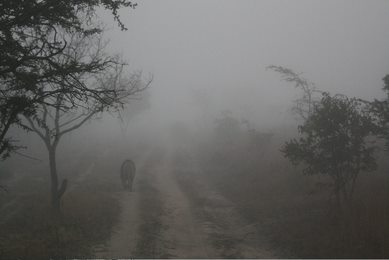
The Ridgeway Ghost
In Wisconsin folklore there is a famous tale called the Ridgeway Ghost. This ghost story was often told during Wisconsin’s pioneer days.
The following is the story of how the belief in this “ghost” was used to dissuade bad behavior.
Sightings of this ghost occurred along an old military road, a 25-mile stretch–known as the Ridge Road– that ox driven wagons traveled in the Lead Region of this state.
The early mining communities of Blue Mounds and Dodgeville in Iowa County book ended this 25-mile stretch. The settlement of Ridgeway that this ghost was named for was halfway between these two mining camps.
The ghost used this settlement as its headquarters.
It was said…
This ghost is unusual in that it can change its’ shape.
This phantom was a man with a whip that chased the living.
Or this ghost was a headless horseman.
Or even creepier–this entity was a fierce beast like creature or ball of fire.
People warned…
This haunting was the result of a bar fight. Two brothers–14 and 15 years old–had the misfortune to be involved in a saloon brawl in the 1840s.
A rowdy threw the 14-year old into a fireplace where he burned to death. The other brother managed to escape but froze to death on his way home.
A Respected witness…
Doctor Cutler of Dodgeville was the first person to see this ghost in the 1850s.
He stated the face of the ghost appeared on a pole on his wagon as he was driving home one night–just as he passed the home of the deceased brothers.
Most frightening of all…
This entity would attack travelers and then would immediately disappear.
Several witnesses, including a well-liked man named John Lewis, who saw this ghost were then plagued by ailments and died.
Locals started to refuse to go out at night alone.
Along this 25-mile stretch, between Dodgeville and Pokerville, were at least a dozen saloons each with a worse reputation than the last.
Gamblers, miners and “toughs” frequented these establishments.
Tavern fights often broke out between drunks and robberies and murders were a common occurrence.
Many of the miners and locals were Welsh and Cornish folk–both these cultures were steeped in old superstitions.
As the story goes the Ridgeway Ghost was manufactured to help rid the region of the disreputable element, which hung out in these saloons.
Practical jokers then helped to spread the growing belief in this ghost. It only took a few “pranks” which then threw the entire region into a panic.
In 1910 when the town of Ridgeway burnt down it is said that this entity moved to the woods near Mineral Point.
#The Ridgeway Ghost#paranormal#paranormal phenomena#ghost and hauntings#ghost and spirits#haunted salem#myhauntedsalem
16 notes
·
View notes
Text

St. Yves’ Day Special: The Ankou
~ ~
Our third Celtic Month piece celebrates St. Yves’ Day, the national day of Brittany; which is on May 19th. Remember to sing some Breton folk songs.
Before you read what the piece means to me, share what it means to _you_. I’m just the artist; you’re the beholder.
Leave a comment.
~ ~
The Bretons dwell in Brittany, a peninsula of France; and both the people and their homeland derive their name from their origin as Britons who fled from Britain to the mainland during the Anglo-Saxon invasion. They are the only Celts who live in mainland Europe, at present; but they came from the Isles. The Breton language is closely related to Welsh and even more closely related to Cornish.
In Breton folklore, the Ankou is said to be an assistant to Death; a figure in a black cloak and hat who collects the souls of the dead and guides them into the afterlife.
Many tales are told about his origins. Some say he was the first child of Adam and Eve, and the first human being to die. Others say he was a prince who challenged Death, and lost.
Others say, and this is the notion I prefer, that the Ankou is the last, or first, person to die in each parish each year; responsible for guiding souls for one year until another takes their place. That way, the dead are greeted by a familiar personage when it’s time to make their final journey.
There are equivalent legends in Cornwall and Wales; the Cornish term is Ankow, and the Welsh term is Angau. There are comparable legends elsewhere. According to a Scottish legend, the last person buried in a graveyard is responsible for guarding it until the next burial. In parts of England there are legends that the first person buried in a graveyard will be responsible for guarding it; and customarily, a dog is buried first, to become the graveyard’s church-grim (a well and truly good boy).
The soldier in the grave, whose soul is being beckoned by the Ankou, as well as the priest performing the funeral liturgy, are a homage to one of my favorite Breton folk songs, Ar Soudarded (Zo Gwisket e Ruz). The chorus-verse means “The soldiers dress in red; the priests dress in black.” It’s a melancholy song about a soldier who speaks of his burial if he should die.
I chose to depict the dead spectres in monochrome; and I’m not sure it was an effective choice. I found it necessary to add the luminous peach-colored halos to clarify the intended effect.
The steeple in the background is inspired by the distinctive cutout designs in the steeple of Tréguier Cathedral.
St. Yves of Kermartin, also called St. Yves Hélory, whose name is also spelled all sorts of other ways such as Ives, Ivo, Erwan, Iwan, Youenn, and Eozenn, and who is not to be confused with St. Yves of Chartres, St. Erbin of Dumnonia, or anyone with the surname Saint-Yves, was a pious clergyman and lawyer who was known for representing the poor and vulnerable, refusing bribes, and unraveling the tricks of swindlers. Every year on his feast day, May 19th, Catholic lawyers from around the world gather at his major shrine at Tréguier Cathedral to pay pilgrimage. Tréguier is also one of the seven sites of the Tour of Brittany, although not because of St. Yves.
The two women mourning at the burial are wearing distinctive traditional stovepipe bonnets, a notable feature of Breton dress.
#st_yves_day#st_yves#brittany#breton#treguier#ankou#death#celts#celtic#spring#springholidays#digitalart#vector#mosaic#collage#inkscape
7 notes
·
View notes
Photo

Raymond Briggs, who has died aged 88, did a great deal to elevate the art of illustration to being something much more than a servant of the written word. Though he was best known for his hugely popular books Father Christmas (1973) and The Snowman (1978), his output also explored themes such as war, politics and the environment through a deeply human, very British lens that often settled on the quiet heroism of ordinary lives.
Briggs may be seen to sit comfortably in the English anecdotal tradition exemplified by Randolph Caldecott in the 19th century and Edward Ardizzone in the 20th, but his often wordless graphic literature built bridges between the picture book and the comic or graphic novel, introducing a new way of reading to the adult publishing market, or at least asking grownups to relearn the business of reading a silent visual sequence.
He started out in 1957 by hawking his portfolio around as a graduate of the Slade School of Fine Art, London, picking up freelance illustration work from newspapers, magazines and design studios. His first book commission came from the editor Mabel George at Oxford University Press, in the form of illustrations to Peter and the Piskies: Cornish Folk and Fairy Tales (1958) by Ruth Manning-Sanders.
George championed the work of a number of artists who were to transform picture-book illustration in the early 1960s, including Brian Wildsmith and Charles Keeping. She sought out printers who were at the cutting edge of developing technology, and who could do justice to the work of these emerging artists. But, as with most illustrators, Briggs’s early working years involved undertaking a range of commissions, drawing anything and everything, starting off with a schematic diagram for House and Garden magazine in 1957 – “how deep to plant your bulbs”.
As various narrative texts came his way, he realised that not all of them were of the highest quality, and took to writing himself. In 1961 he wrote and illustrated two books, Midnight Adventure and The Strange House, for the publishers Hamish Hamilton, with whom he would have a lasting working relationship.
That year, he began teaching illustration part-time at Brighton College of Art (now Brighton University’s faculty of arts) at the invitation of the then head of department, the calligrapher and engraver John R Biggs. He continued to teach for a day a week at Brighton until 1987, and his tuition was much admired and appreciated by generations of artists including the prolific illustrator and Observer political cartoonist Chris Riddell.
In 1963 Briggs had married the painter Jean Taprell Clark. Her death from leukaemia in 1973, and the deaths of his parents, led Briggs to throw himself into his work. A major breakthrough had already come in 1966, with The Mother Goose Treasury, for which he received his first Kate Greenaway medal. Father Christmas brought him a second, and catapulted him to fame. His grumbling, lavatorial and flawed Santa was immensely popular.
As with all Briggs’s subsequent titles, the book is full of autobiographical elements and references. His own childhood home and Loch Fyne holidays appear regularly and he himself pops up in the follow-up, Father Christmas Goes on Holiday (1975).
Briggs can be found standing ahead of Father Christmas in the queue for a shave at the campsite, along with the illustrator John Vernon Lord (sporting his initials on his wash bag). The author’s VW Camper van would make regular appearances too. Fungus the Bogeyman (1977) could also be seen as a character very much close to home, displaying as he does an extreme version of the author’s own tendency to be outspoken and impatient.
At Hamish Hamilton the newly arrived editor Julia MacRae (later to set up her own imprint) played a major role in developing the artist’s career. The illustrator John Lawrence, who was also published by Hamish Hamilton, recalled those days with great fondness: “All the talk was about ‘is the world ready for Fungus the Bogeyman?’ and we all turned up at the launch party in green wellingtons surrounded by buckets of suspicious-looking green liquid, wondering whether it might be the wine.”
The subject of mortality formed a recurrent theme, addressed explicitly in Briggs’s account of his parents’ lives, Ethel & Ernest: A True Story (1998), which was made into an admired full-length animation broadcast at Christmas in 2016, and implicitly in the melting at the end of The Snowman and the disappearance of The Bear in the 1994 book of that name.
But perhaps the most powerful motivation was a hatred of injustice by authority toward the powerless and naively respectful common man. The latter could be seen most directly in When the Wind Blows (1982), Briggs’s examination of an elderly couple’s attempts to follow government guidelines as nuclear war breaks out; and The Tin-Pot General and the Old Iron Woman (1984), a thinly disguised General Leopoldo Galtieri and Margaret Thatcher.
In 1982 he told the Times: “When I did [When the Wind Blows] I was not remotely a CND supporter. I simply thought it was good subject. It is highly depressing and fairly political, and I could not even think who was going to buy it. But I never think of the potential audience when I embark on a book; this was not even done specifically for children.”
Nevertheless, the children of his long-term partner, Liz, provided inspiration and source material for other projects, notably The Puddleman (2004), which grew from a remark made by one of the young children on passing a puddle while the family were out walking in the countryside.
His final book was consciously intended to be just that. Compiled across several of his last years, Time for Lights Out (2019) is a poignant, funny and deeply honest exploration of the experience of ageing and reaching the end of life, in the form of a collage of verse, drawings and random thoughts.
Many of Briggs’s books were successfully adapted for film and other media, Channel 4’s 1982 animated film version of The Snowman, with its familiar theme song Walking in the Air, became a staple of Christmas Day TV. Briggs endorsed a sequel, The Snowman and the Snowdog, broadcast in 2012. Other books were translated for stage and radio, with Briggs taking a keen interest in the overall production.
He was born in Wimbledon, south-west London, to Ethel (nee Bowyer) and Ernest Briggs. Their first meeting is beautifully described in the wordless opening sequence of the book devoted to their story. Ethel, a young parlour maid in a Belgravia house, had been innocently shaking out her duster from an upper window as Ernest passed by on his bicycle and confidently returned what he took to be a friendly wave.
Briggs attended the local Rutlish school and went on to study at Wimbledon School (now College) of Art, the Central School of Arts and Crafts (now Central Saint Martins) and, after a two-year break for national service, the Slade. His father, a milkman, had tried to dissuade his son from studying at art school, fearing that it would not equip him for stable employment.
Briggs’s keen interest in narrative drawing was not welcomed at Wimbledon School of Art, which was rooted in traditional representational painting. He recalled: “I had gone to art school to learn to draw so as to become a cartoonist. But I was soon told that cartooning was an even lower form of life than commercial art.”
Such prejudices, still not entirely eradicated today, were commonplace at art schools of the time. Although he bemoaned his tutors’ failure to recognise a “natural illustrator”, the formal training that he received imbued in Briggs a strong sense of structure and of the importance of good draughtsmanship. These equipped him well in book illustration, although he left the Slade with what he saw as a poor sense of colour and a dislike of paint. When he eventually arrived at the film version of The Snowman, he expressed pleasure at how it so faithfully and painstakingly replicated his coloured-pencil technique, despite the massively labour-intensive approach that this necessitated.
The characteristic that the journalist John Walsh described in a 2012 interview as a very English “strenuous curmudgeonliness” had become in later years a stereotype that Briggs embraced, exemplified by his column in the Oldie, Notes from the Sofa, collected in book form in 2015, where he would rail against sundry incomprehensible aspects of modern life.
But friends knew another side to Briggs – loyal and playful, an inveterate practical joker. Lord once made the mistake of confessing to a dislike of dogs in the presence of Briggs, thereby immediately committing himself to becoming the recipient of all manner of canine-related gifts on subsequent birthdays and Christmases. Like so many of his characters, Briggs’s grumpiness never quite managed to conceal an underlying warmth and kindness. In 2017 he was appointed CBE.
Liz died in 2015. He is survived by her children, Clare and Tom, and grandchildren, Connie, Tilly and Miles.
🔔 Raymond Redvers Briggs, illustrator and author, born 18 January 1934; died 9 August 2022
Daily inspiration. Discover more photos at http://justforbooks.tumblr.com
27 notes
·
View notes
Text
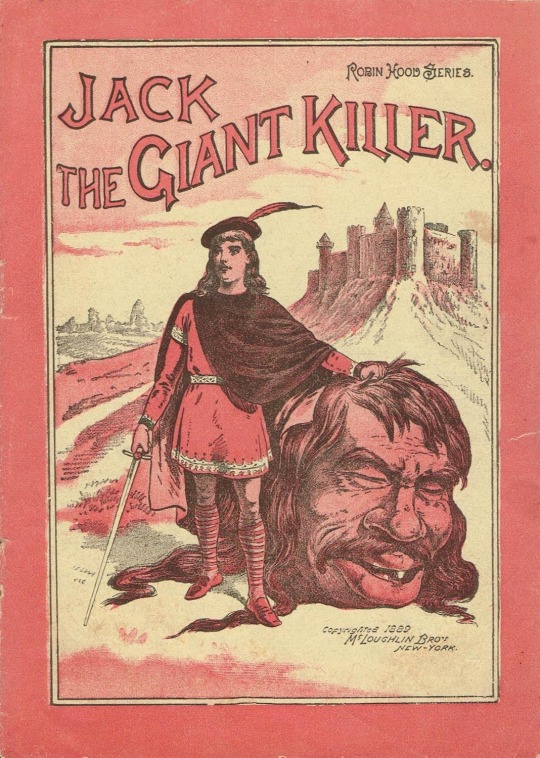



#jack the giant killer#english#fairy tales#fairy tale#folk tales#folklore#jack the giant slayer#monster#slayer#mythology#england#cornish#british#britain#jack#jack and the beanstalk#arthurian#king arthur#giant#giants#ogres#legend#hero#legends#monsters#tales#jack tales#cornwall#robin hood series#english fairy tales
22 notes
·
View notes
Text
Official Competition films announced - 66th BFI London Film Festival
The 66th BFI London Film Festival in partnership with American Express has announced the contenders for the Best Film Award in association with Sight and Sound.
Established in 2009 and first won by Jacques Audiard for A Prophet, recent winners of the Best Film Award include Sudabeh Mortezai’s Joy, Alejandro Landes’ Monos and, in 2021, Panah Panahi’s Hit the Road.
Argentina, 1985 (Argentina, dir-scr. Santiago Mitre)

Ricardo Darín stars in this uncompromising political drama, thrillingly recreating one of Argentina’s most legendary trials, which sought to bring the country’s military dictatorship to justice.
Prosecutor Julio Cesár Strassera is about to embark on the trial of a lifetime, assembling a legal team to try the leaders of the country’s 1976-83 military junta. Director Santiago Mitre deftly handles this pacy investigative courtroom drama, contextualising it within the complex narrative of a country forging a new democracy in the aftermath of the regime’s collapse.
Brother (Canada, dir-scr. Clement Virgo)

Clement Virgo’s film is a bold and breathtaking story of brotherly love, set over three separate time periods, in Toronto’s West Indian community.
When his childhood sweetheart Aisha returns to their Toronto neighbourhood of Scarborough for the first time in 10 years, Michael is forced to revisit a family tragedy. Growing up as young Black boys in a neighbourhood prone to gang violence and police brutality, older brother Francis was Michael’s best friend, protector and even parent when their Jamaican mother worked night shifts. As they grow older, Francis and Michael’s lives diverge, as Francis immerses himself in Scarborough’s West Indian community. But there remains a fierce, unconditional love between the brothers and their mother – it’s them against the world.
Corsage (Austria-Luxembourg-Germany-France, dir-scr. Marie Kreutzer)

Sisi the Empress gets an irreverent make-over in Austrian director Marie Kreutzer’s exhilarating period drama. Vicky Krieps won the Best Actress award in Un Certain Regard at Cannes for that role.
Christmas, 1877. Empress Elizabeth of Austria (Vicky Krieps) is turning 40. Renowned for her beauty, she undertakes daily privations to ensure she fits her wasp-waist corset and keeps her picture-perfect looks. Suffocating in the stuffy Hapsburg court, she finds herself incapable of continuing to conform to the decorative role that is expected of her, instead carrying out desperate acts of rebellion.
Les damnés ne pleurent pas (France-Belgium-Morocco, dir-scr. Fyzal Boulifa)

Fyzal Boulifa follows his arresting debut Lynn + Lucy (LFF 2019) with another striking film about the perils of falling foul of community and social expectations.
Selim and his mother Fatima-Zahra live in close quarters, with so little money that a single moment of bad fortune is a crisis of survival. Man-child Selim has grown up without a father, leaving him and his mother socially marginalised; he’s bound to his mother, but also resents her and offers his love with a dose of petulance. In a starkly patriarchal society, Fatima-Zahra needs Selim just as much as he leans on her. When a trip to her family village reveals some troubling secrets, a rift opens that will see them try to establish their independence from each other, but tests their fragile love.
Enys Men (UK, dir-scr. Mark Jenkin)
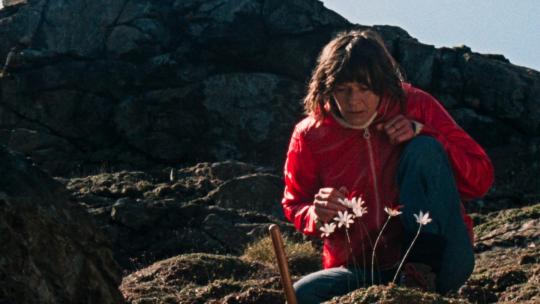
Bait director Mark Jenkin follows up his acclaimed debut with this chilling, endlessly mysterious folk horror tale, beautifully shot on grainy 16mm.
On a remote island off the Cornish coast, a volunteer environmentalist records daily observations about a rare flower growing near the cliff edge. Going about her tasks with meticulous care, the nameless ecologist lives a life of isolation and repetition, her routine only occasionally interrupted by a local man who comes to deliver petrol for her antique power generator. But as changes suddenly appear on the plant she is studying, the boundaries between reality and fantasy begin to blur, plunging the volunteer into a nightmarish, metaphysical dreamscape.
Godland (Denmark-Iceland-France-Sweden, dir-scr. Hlynur Palmason)
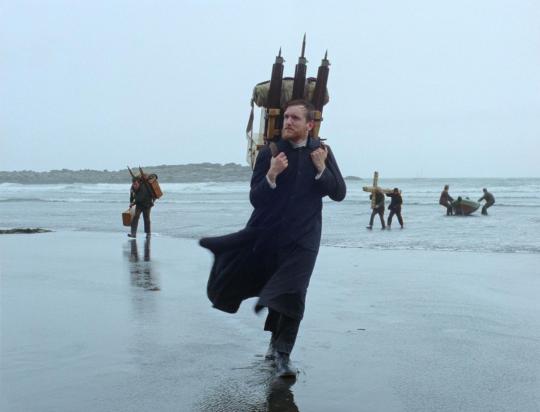
With his third feature, Hlynur Pálmason (A White, White Day) delivers a breathtakingly inventive and ambitious historical epic, set in mid-19th-century Iceland.
A young Danish priest is sent to a remote Icelandic outpost to establish a church. Convinced of his moral purpose and fortitude, he travels via the most treacherous route to document the country’s stark beauty with his silver plate photography. It’s a dangerous crossing, guided by locals who disdain their Danish colonisers.
Nezouh (UK-Syria-France, dir-scr. Soudade Kaadan)
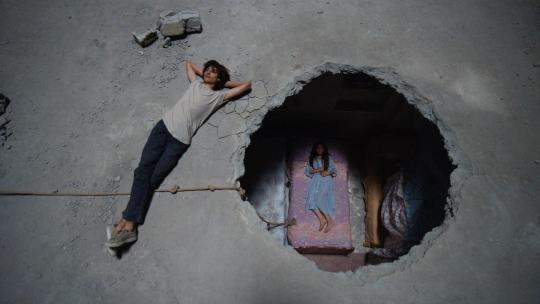
Soudade Kaadan (The Day I Lost My Shadow, LFF 2018) turns to her Syrian roots for this wry, poignant look at a family forced from their home in Damascus.
When a missile destroys her family’s apartment, teenager Zeina and her mother believe her father Mutaz will finally concede that they need to leave the devastated Syrian capital. But Mutaz (Samer al-Masri, The Worthy) refuses to become a refugee, resolutely patching up the family’s home with bedsheets. With the interior becoming the exterior, Zeina and her mother are more exposed to the outside world than ever before. The invitation of a rope through a hole in her blasted ceiling leads to an encounter with the neighbour’s son Amer, to stars, imaginary fishing and movies.
Saint Omer (France, dir. Alice Diop)

Alice Diop reinvents the courtroom drama in this concentrated, gripping study of a writer and the young African woman whose fate comes to fascinate her.
Acclaimed as a documentarist, notably for 2021’s Nous, Diop turns to fiction with this riveting, stylistically spare take on the courtroom tradition. Kayije Kagame plays Rama, a writer who travels to northern France to follow the trial of Laurence, a young African woman accused of killing her daughter. As she listens to the various testimonies, Rama’s own condition – as an artnezouhist, a lover and a Black woman in France – also falls into a questioning perspective.
The winner of the Best Film Award will be announced at a special virtual LFF awards ceremony event on Sunday 16 October on BFI YouTube and social media.
#news#LFF#BFI#bfi london film festival#official competition#alice diop#saint omer#nezouh#godland#enys men#les damnes ne pleurent pas#corsage#vicky krieps#argentina#brother
6 notes
·
View notes
Text
My alternate self has been in Lisbon for a week now, and my real self still knows nothing about Portugal. Sad.
Wikipedia is always a good place to start. I thought this section about how Portugal got its name was pretty interesting.
The word Portugal derives from the combined Roman-Celtic place name Portus Cale;[24][25] a settlement where present-day’s conurbation of Porto and Vila Nova de Gaia (or simply, Gaia) stand, along the banks of River Douro in the north of what is now Portugal. The name of Porto stems from the Latin word for port or harbour, portus, with the second element Cale’s meaning and precise origin being less clear. The mainstream explanation points to an ethnonym derived from the Callaeci also known as Gallaeci peoples, who occupied the north-west of the Iberian Peninsula.[26] The names Cale and Callaici are the origin of today's Gaia and Galicia.[27][28]
There are some Hungarian folk songs that refer to "Galicia" and I'm not sure why. I just remember wondering where the heck Galicia is. It's in present-day Portugal? Why would Hungarians be singing about that? Maybe there's more than one Galicia.
Another theory proposes that Cale or Calle is a derivation of the Celtic word for 'port', like the Irish caladh or Scottish Gaelic cala. These explanations, would require the pre-Roman language of the area to have been a branch of Q-Celtic, which is not generally accepted because the region's pre-Roman language was Gallaecian. However, scholars like Jean Markale and Tranoy propose that the Celtic branches all share the same origin, and placenames such as Cale, Gal, Gaia, Calais, Galatia, Galicia, Gaelic, Gael, Gaul (Latin: Gallia),[29] Wales, Cornwall, Wallonia and others all stem from one linguistic root.[27][30][31]
Whoa! That's cool! I love when you can see the connections between different languages and see the changes and divergence over time.
A further explanation proposes Gatelo as having been the origin of present-day Braga, Santiago de Compostela, and consequently the wider regions of Northern Portugal and Galicia.[32] A different theory has it that Cala was the name of a Celtic goddess (drawing a comparison with the Gaelic Cailleach, a supernatural hag). Further still, some French scholars believe the name may have come from Portus Gallus,[33] the port of the Gauls or Celts.
So basically, lots of great guesses.
Around 200 BC, the Romans took the Iberian Peninsula from the Carthaginians during the Second Punic War. In the process they conquered Cale, renaming it Portus Cale ('Port of Cale') and incorporating it in the province of Gaellicia with its capital in Bracara Augusta (modern day Braga, Portugal). During the Middle Ages, the region around Portus Cale became known by the Suebi and Visigoths as Portucale. The name Portucale evolved into Portugale during the 7th and 8th centuries, and by the 9th century, that term was used extensively to refer to the region between the rivers Douro and Minho. By the 11th and 12th centuries, Portugale, Portugallia, Portvgallo or Portvgalliae was already referred to as Portugal.
The Carthaginians. I remember learning about the Carthaginians during my university studies an eon ago. I don't remember who they were or what happened to them. Time to delve into some ancient history, perhaps?
The 14th-century Middle French name for the country, Portingal, which added an intrusive /n/ sound through the process of excrescence, spread to Middle English.[34] Middle English variant spellings included Portingall, Portingale,[note 5] Portyngale and Portingaill.[34][36] The spelling Portyngale is found in Chaucer's Epilogue to the Nun's Priest's Tale. These variants survive in the Torrent of Portyngale, a Middle English romance composed around 1400, and "Old Robin of Portingale", an English Child ballad. Portingal and variants were also used in Scots[34] and survive in the Cornish name for the country, Portyngal.
Excrescence! Gesundheit. Thank you.
Well that was an interesting little linguistic side trip. I'm always curious about how countries got their names.
1 note
·
View note